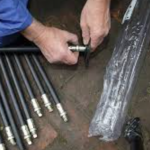If you were to dig about 10 to 20 metres below the earth in Gloucester, you would come across the remains of the City’s ancient past. You would have to get through the days of the Victorians and the powerful docks that brought much wealth and prosperity. Next, you would have to cut through its days in the Civil war as a stronghold for the Parliamentarians against the Royalists. For almost a month, the City desperately held out against the forces of the King, who were trying to wrestle control of the Severn valley and gain access to the rich trade route. Then you would find the medieval phase of the City and its standing as a part of Wessex or Mercia, depending on the ever-changing shape of England at the time. Finally, you would hit upon the remains of what the City once was. The massive Roman City of Glevum.

It is easy to see why the Roman’s chose to develop the site. It sits at the top of the Severn Sea, or the Bristol Channel as we would call it now, and the River is very navigable. Trade Galleys would be able to pile their goods as they brought in imported riches and products from all over the Roman Empire. This would have meant the City was a hub for life, seeing many different faces and cultures coming to trade and set up in the new world. It soon began to overtake the closest neighbour, Cirencester. In the second Century, Cirencester, or Corinuim, was the second-largest city next to London. As the trade began to expand Glevum, things soon began to change.

The driving force behind Glevums’ success in Roman Britain was its founding. Corinium was created as a new home and reward for the local Dobunni tribe, who had assisted the Romans in subduing rebellious tribes like the Cataluviani and the Iceni. Glevum’s creation was altogether very different. It was set up as a place for the retiring all-conquering Legionnaires to go and live out the rest of their life in peace and comfort. They would move in with their family and take advantage of the City’s wealth and its highly nutritious soil. They could have a luxurious Villa, or a modest one, depending on the pension and wealth they had accrued during military life. Because of its location near the border of Wales and the access to the Severn, it was also the location for an active Garrison. The Roman Legionary needed to be ready to go anywhere and fight in any part of the Empire whenever called to do so.
The remains of the Roman City can be seen at several points throughout the City, and a tour is available. Residents of Gloucestershire Park Homes have most definitely been on it. If you are considering retiring to Gloucester, like those Legionaries of old, why not visit Park Home Life to see what’s available to you.










